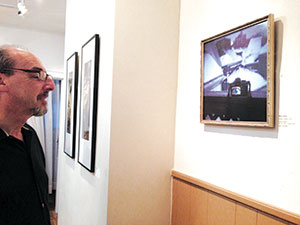
Somerville Toy Camera Festival co-organizer James Zall at the Nave Gallery Annex last Thursday. — Photo by Josie Grove
By Josie Grove
The third annual Somerville Toy Camera Festival began last Thursday with a small reception at the Nave Gallery Annex near Davis Square. The unassuming white house that is the gallery space slowly filled with photography enthusiasts and toy camera fans.
Toy cameras are very simple film cameras that give the photographer less control over the amount of light in an image than a more sophisticated camera. “There is definitely kind of like a mysterious thing going on,” said Bonnie B., one of the festival’s co-organizers. “You don’t really know what you’re going to get. With a camera that has full exposure control, you kind of have a pretty good idea of what you’re going to get, if you know what you’re doing. But if you’re using a toy camera with no shutter speed and no aperture or anything like that, you’re winging it, and it’s kind of cool. Also, a lot of them have weird imperfections that they impart to the photos, that are actually pretty nice.” The photographs in the galleries are full of speckles, lines, and flashes that are a result of quirks in the toy cameras.
The cameras may be toys, but the competition is serious. The festival is juried by Los Angeles-based photographer Aline Smithson, who runs the blog LENSCRATCH. Smithson selected 125 images from the open call to be part of the festival. The call for submissions was open to anyone with a toy camera.

Image detail: Bill Franson, Boston, MA; Holga 120, Ilford HP5.
Toy cameras are generally inexpensive and easy to use, which makes it easier to submit work. “It’s kind of low tech, and that’s very attractive in a world where everybody’s talking about how much money you spent on the latest thirty megapixel cameras” said Susan Berstler, who organizes the festival and runs the Nave Gallery.
The work of professionals and amateurs is exhibited side by side. “We have people who shot for he very first time. We have two high school students in the show, and we have them on the wall with everybody else,” said Berstler. “You don’t know which ones the high school kids are and which ones the famous photographers are. You might have a guess when you look at how much money they spent on the frame, but you can’t tell from the images.”
“Somerville has an amazingly talented community of artists, local artists, and the greater Boston community even more so. But from the very beginning, our shows have been from thirty to fifty percent, or in this case even more, people from other places. I think as an artist, it’s wonderful to have your work hanging next to have your work hanging next to somebody from Germany or the Ukraine, or Israel, or last year we had someone from Iran. It’s kind of like taking he artistic community and Somerville and broadening it.”
Berstler wants to spread the festival across Somerville. “We could have done his for just the two Nave spaces,” she said. “It would have been a lot less complicated, it would have been a lot easier. But being able to make it a citywide event has been a lot of fun.”
At least part of the fun comes from the idea that beautiful images can come from rudimentary cameras, says Berstler. “People are always amazed that a pinhole or a piece of plastic can take some of these images.”
The festival runs through the end of September. “We have a number of events tied to the festival,” said Berstler. “One of them is called Darkroom Day. You can sign up to spend eight hours in the darkroom.” Other events include a street photography workshop, and a space for toy camera enthusiasts to share lo-fi camera techniques,
The festival is becoming better known to artists outside of New England, and is connecting artists across geography. “So many of the artists are from other places,” says Berstler. They start to have these friendships they’ve created. The person in Italy is talking to the person in California who knows the person in Chicago. It’s a really small network in some ways, and we keep growing it. We keep bringing in new people.”















Reader Comments